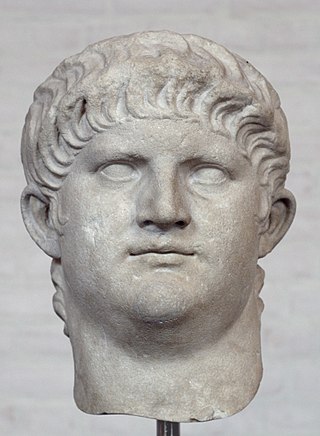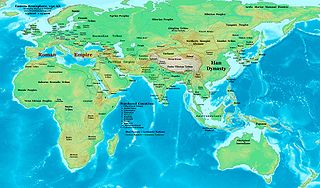Related Research Articles

Nero Claudius Caesar Augustus Germanicus was Roman emperor and the final emperor of the Julio-Claudian dynasty, reigning from AD 54 until his death in AD 68.

The 1st century was the century spanning AD 1 through AD 100 (C) according to the Julian calendar. It is often written as the 1st century AD or 1st century CE to distinguish it from the 1st century BC which preceded it. The 1st century is considered part of the Classical era, epoch, or historical period. The Roman Empire, Han China and the Parthian Persia were the most powerful and hegemonic states.
AD 68 (LXVIII) was a leap year starting on Friday of the Julian calendar. At the time, it was known as the Year of the Consulship of Silius Italicus and Trachalus, or the start of the Year of the Four Emperors. The denomination AD 68 for this year has been used since the early medieval period, when the Anno Domini calendar era became the prevalent method in Europe for naming years. These are now used throughout the world.

The 10s decade ran from January 1, AD 10, to December 31, AD 19.

The 30s decade ran from January 1, AD 30, to December 31, AD 39.

The 50s decade ran from January 1, 50, to December 31, 59. It was the sixth decade in the Anno Domini/Common Era, if the nine-year period from 1 AD to 9 AD is considered as a "decade".

The 60s decade ran from January 1, AD 60, to December 31, AD 69.

The 80s was a decade that ran from January 1, AD 80, to December 31, AD 89.

The 100s was a decade that ran from January 1, AD 100, to December 31, AD 109.
AD 25 (XXV) was a common year starting on Monday of the Julian calendar. At the time, it was known as the Year of the Consulship of Lentulus and Agrippa. The denomination AD 25 for this year has been used since the early medieval period, when the Anno Domini calendar era became the prevalent method in Europe for naming years.
AD 4 was a common year starting on Wednesday or a leap year starting on Tuesday of the Julian calendar and a leap year starting on Tuesday of the Proleptic Julian calendar. In the Roman Empire, it was known as the Year of the Consulship of Catus and Saturninus. The denomination "AD 4" for this year has been used since the early medieval period, when the Anno Domini calendar era became the prevalent method in Europe for naming years.
AD 49 (XLIX) was a common year starting on Wednesday of the Julian calendar. At the time, it was known as the Year of the Consulship of Longus and Veranius. The denomination AD 49 for this year has been used since the early medieval period, when the Anno Domini calendar era became the prevalent method in Europe for naming years.
AD 51 (LI) was a common year starting on Friday of the Julian calendar. At the time, it was known as the Year of the Consulship of Caesar and Scipio. The denomination AD 51 for this year has been used since the early medieval period, when the Anno Domini calendar era became the prevalent method in Europe for naming years.
AD 52 (LII) was a leap year starting on Saturday of the Julian calendar. At the time, it was known as the Year of the Consulship of Sulla and Otho. The denomination AD 52 for this year has been used since the early medieval period, when the Anno Domini calendar era became the prevalent method in Europe for naming years.
AD 57 (LVII) was a common year starting on Saturday of the Julian calendar. At the time, it was known as the Year of the Consulship of Caesar and Piso. The denomination AD 57 for this year has been used since the early medieval period, when the Anno Domini calendar era became the prevalent method in Europe for naming years.
AD 58 (LVIII) was a common year starting on Sunday of the Julian calendar. At the time, it was known as the Year of the Consulship of Caesar and Messalla. The denomination AD 58 for this year has been used since the early medieval period, when the Anno Domini calendar era became the prevalent method in Europe for naming years.

AD 60 (LX) was a leap year starting on Tuesday of the Julian calendar. At the time, it was known as the Year of the Consulship of Nero and Lentulus. The denomination AD 60 for this year has been used since the early medieval period, when the Anno Domini calendar era became the prevalent method in Europe for naming years.
AD 63 (LXIII) was a common year starting on Saturday of the Julian calendar. At the time, it was known as the Year of the Consulship of Regulus and Rufus. The denomination AD 63 for this year has been used since the early medieval period, when the Anno Domini calendar era became the prevalent method in Europe for naming years.
Year 101 (CI) was a common year starting on Friday of the Julian calendar. At the time, it was known as the Year of the Consulship of Traianus and Paetus. The denomination 101 for this year has been used since the early medieval period, when the Anno Domini calendar era became the prevalent method in Europe for naming years.

Aristobulus of Britannia is a Christian saint named by Hippolytus of Rome (170–235) and Dorotheus of Gaza (505–565) as one of the Seventy Disciples mentioned in Luke 10:1–24 and as the first bishop in Roman Britain.
References
- ↑ Platina (1471). The Lives of the Popes: From the Time of Our Saviour Jesus Christ, to the Reign of Sixtus IV. C. Wilkinson. p. 7.
- ↑ Fabry, Merrill (August 31, 2016). "Now You Know: When Did People Start Saying That the Year Was 'A.D.'?". Time . Retrieved October 13, 2021.
- ↑ Cartwright, Mark (March 6, 2018). "The Roman-Parthian War 58-63 CE". World History Encyclopedia . Archived from the original on April 17, 2021. Retrieved October 13, 2021.
- ↑ Fontán, Antonio (2002). Humanismo y pervivencia del mundo clásico. Ediciones del Laberinto. p. 1284. ISBN 9788484831563.
- ↑ Hing, Ming Hung (2020). The Magnificent Emperor Wu: China's Han Dynasty. Algora Publishing. ISBN 9781628944181.
- ↑ MacDonald, Alexander Hugh. "Tacitus". Encyclopaedia Britannica. Retrieved February 22, 2024.
- ↑ Pliny the Elder, Natural History VII.62